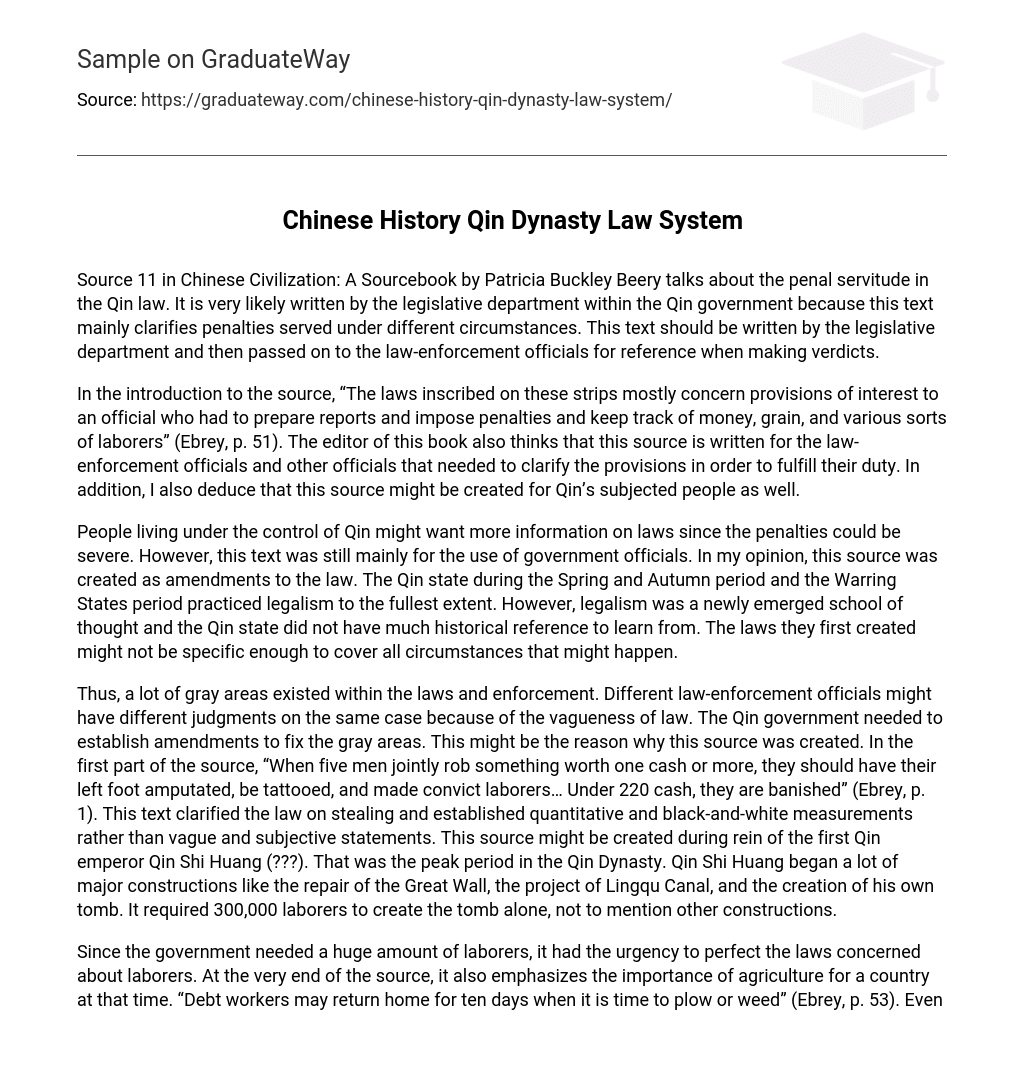Source 11 in Chinese Civilization: A Sourcebook by Patricia Buckley Beery talks about the penal servitude in the Qin law. It is very likely written by the legislative department within the Qin government because this text mainly clarifies penalties served under different circumstances. This text should be written by the legislative department and then passed on to the law-enforcement officials for reference when making verdicts.
In the introduction to the source, “The laws inscribed on these strips mostly concern provisions of interest to an official who had to prepare reports and impose penalties and keep track of money, grain, and various sorts of laborers” (Ebrey, p. 51). The editor of this book also thinks that this source is written for the law-enforcement officials and other officials that needed to clarify the provisions in order to fulfill their duty. In addition, I also deduce that this source might be created for Qin’s subjected people as well.
People living under the control of Qin might want more information on laws since the penalties could be severe. However, this text was still mainly for the use of government officials. In my opinion, this source was created as amendments to the law. The Qin state during the Spring and Autumn period and the Warring States period practiced legalism to the fullest extent. However, legalism was a newly emerged school of thought and the Qin state did not have much historical reference to learn from. The laws they first created might not be specific enough to cover all circumstances that might happen.
Thus, a lot of gray areas existed within the laws and enforcement. Different law-enforcement officials might have different judgments on the same case because of the vagueness of law. The Qin government needed to establish amendments to fix the gray areas. This might be the reason why this source was created. In the first part of the source, “When five men jointly rob something worth one cash or more, they should have their left foot amputated, be tattooed, and made convict laborers… Under 220 cash, they are banished” (Ebrey, p. 1). This text clarified the law on stealing and established quantitative and black-and-white measurements rather than vague and subjective statements. This source might be created during rein of the first Qin emperor Qin Shi Huang (???). That was the peak period in the Qin Dynasty. Qin Shi Huang began a lot of major constructions like the repair of the Great Wall, the project of Lingqu Canal, and the creation of his own tomb. It required 300,000 laborers to create the tomb alone, not to mention other constructions.
Since the government needed a huge amount of laborers, it had the urgency to perfect the laws concerned about laborers. At the very end of the source, it also emphasizes the importance of agriculture for a country at that time. “Debt workers may return home for ten days when it is time to plow or weed” (Ebrey, p. 53). Even though these laborers had defaulted on loans and owned government money, they were still allowed to go home and do agricultural work. This indicates that the Qin government paid very much attention on agriculture and peasant was a respected occupation.
This source reveals the elaboration of Qin’s law system. By practicing legalism, Qin outran and conquered all other states. But it is also legalism that eventually destroyed the Qin dynasty. Despite legalism’s harshness, we cannot deny its contribution on regulating a country. This source allows us to investigate the complexity in Qin’s legal system in detail and makes it possible for historians to understand Qin’s history accurately.
Work Cited
Ebrey, Patricia Buckley. Chinese Civilization: A Sourcebook. New York: The Free Press, 1993. Print.





